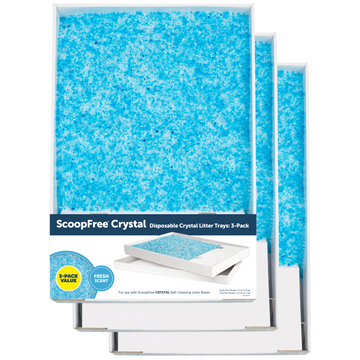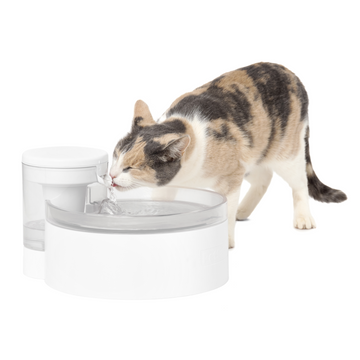
May 9, 2024
PetSafe® Expert
PetSafe® Guest
How To Stop Cat From Peeing On Carpet
Have you ever walked into a room only to be greeted by the unmistakable scent of cat urine on your carpet? You're not alone. Many cat owners face the puzzling and often frustrating issue of their feline friends deciding the carpet is as good a place as any for a bathroom break. We understand the challenges and inconveniences that come with loving and living with pets. That’s why we're here to help you understand this behavior and guide you through effective ways to ensure your cat uses their litter box instead of your carpet.
In this guide, we'll explore the reasons behind this troublesome behavior, share preventive tips to help keep your carpets clean, and provide practical solutions if your cat has already turned a corner of your home into their personal restroom. Our goal is to help you maintain a happy, healthy environment where both you and your cat can thrive.
Understanding Why Cats Pee on Carpets
When your cat chooses the carpet over the litter box, it’s not just to drive you up the wall. There are several underlying reasons why your cat might be avoiding their designated bathroom spot. By understanding these, you can better address the problem at its root.
1. Medical Concerns: Health issues can often lead to inappropriate urination. Conditions like urinary tract infections, kidney disease, or diabetes can make your cat urinate more frequently or urgently, and they might not make it to the litter box in time. Regular vet check-ups are crucial to rule out these possibilities.
2. Behavioral Factors: Cats are creatures of habit and extremely sensitive to their environments. If something about their litter box is off—whether it’s too dirty, poorly placed, or the wrong type of litter—they might opt for your carpet instead. Stress can also play a significant role. Changes in your home like new pets, visitors, or even rearranging furniture can unsettle your cat.
3. Litter Box Issues: The size, type, and cleanliness of the litter box can all influence your cat's litter behavior. A box that’s too small, too enclosed, or not cleaned often enough can dissuade your cat from using it. Additionally, the type of litter used can affect their preference; some cats have specific preferences for finer textures or unscented options.
Addressing these factors involves a bit of detective work and understanding your cat’s preferences and needs. It's about creating a welcoming, stress-free bathroom experience that encourages them to stick to the litter box.

Preventive Measures
Preventing your cat from peeing on the carpet starts with proactive steps to make the litter box the most appealing option. Here’s how you can set up your home to encourage good litter box habits:
1. Optimal Litter Box Setup: Place the litter box in a quiet, low-traffic area where your cat feels safe and undisturbed. Avoid noisy appliances and high-footfall areas that might deter your cat from using the box. If you have a multi-story home, consider placing a litter box on each floor. Remember, the goal is convenience and comfort for your cat.
2. Litter Box Hygiene: Keeping the litter box clean is essential. Scoop the waste daily and change the litter regularly to maintain a fresh and appealing environment. Consider the ScoopFree® Crystal Smart Self-Cleaning Litter Box for an always-clean litter experience that reduces the hassle for you and keeps the box more inviting for your cat.
3. Right Litter Choice: Experiment with different types of litter to find your cat’s preference. Some cats prefer the fine texture of clumping litter, while others might favor a more natural feel.
4. Stress Reduction: Create a calming environment to minimize stress-related behaviors. This can include pheromone diffusers, providing plenty of hideouts and high perches, and maintaining a routine that gives your cat security and predictability. Regular playtime and interaction can also reduce stress and prevent behavioral issues.
By implementing these preventative measures, you not only deter your cat from using your carpet as a litter box but also enhance their overall well-being and happiness in your home.
When to See a Vet
Recognizing when your cat’s behavior is a sign of a deeper health issue is key to their well-being and your peace of mind. It’s essential to monitor their habits and note any significant changes that might require professional attention. Here’s when you should consider a vet visit:
1. Sudden Changes in Litter Box Habits: If your cat, who has been consistent with litter box use, suddenly starts avoiding it, it could be a signal of discomfort or illness. This is particularly true if they seem to struggle, vocalize, or frequently enter and leave the litter box without urinating.
2. Signs of Discomfort or Pain: Watch for signs of pain such as meowing or crying when urinating, licking the urinary area excessively, or visible blood in the urine. These symptoms can indicate urinary tract infections, blockages, or other serious health conditions.
3. Behavioral Changes: If your cat shows other signs of distress, such as a decrease in appetite, lethargy, or unusual aggression, these could be linked to their litter box problems and suggest underlying health issues.
4. No Improvement with Home Remedies: If you’ve tried the solutions outlined and there’s no improvement, or the situation worsens, it’s time to seek veterinary help. A professional can conduct tests to diagnose the issue and prescribe the necessary treatments.
Your vet can provide a comprehensive health check to rule out or treat medical causes of inappropriate urination. Early intervention is crucial, not just for the health of your cat but also for preventing long-term habits from forming. A healthy cat is a happy cat, and ensuring they have the proper care is the best way to maintain their health and happiness.
Conclusion
Addressing the issue of your cat peeing on the carpet can be challenging, but with the right knowledge and tools, it is manageable. By understanding the potential reasons behind this behavior, taking preventive measures, applying effective solutions, and knowing when to seek professional help, you can help your cat overcome this undesirable habit. Remember, the key to success lies in patience, consistency, and a compassionate approach to your cat's needs.
Get Email Updates
Subscribe to the latest news, promotions, & more from PetSafe® brand.
Sign up today for the latest news, promotions, and more from PetSafe® brand.





